This is an old revision of the document!
Thomas de Montmorenci, Florence and Mary M-P
Thomas de Montmorenci Murray-Prior (1848-1902) was the 4th consecutive Thomas Murray-Prior. He was TLM-P and Matilda M-P's eldest son, born 27 January 1848 at his father's property Bromelton.
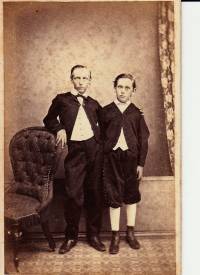 Young 'Tommy' de Montmorenci M-P with his brother Morres, from his father's album.
Young 'Tommy' de Montmorenci M-P with his brother Morres, from his father's album.
Colin Roderick's biography of Rosa Praed refers to a letter by Matilda to her mother-in-law describing how their property Bromelton was isolated by a flood when she gave birth to Thomas: 'Having neither doctor nor nurse, and knowing that I might die before there was any hope of medical assistance, I endeavoured to prepare my mind for leaving this world.'1) Death was a distinct possibility for her baby too, given he was premature.2) It is not known if Matilda's difficulties were compounded by the knowledge that Emma Quin also gave birth in 1848 and that it would later be believed that the father was TLM-P.
Thomas de M was baptised at Bromelton by the Rev. Benjamin Glennie3) and went to school in Brisbane and Hobart. After that, for a time at least, he worked on Maroon. A letter by his sister Rosa to her father in the late 1860s indicates that Tom encouraged, and to a degree shared, her literary inclinations. His praise was tempered by his times ('Tom liked it. He said it was like a man's work.') but he also shared and encouraged her writing the Marroon Magazine and her determination to educate her intellect: 'Tom and I had a long dissertation last night upon the cultivation of the understanding and he is going to follow my plan, and write notes and remarks upon everything he reads.'4)
At some unknown date, Nora chose lines from poetry to describe her step-children and children. The lines she chose for her eldest stepson were: 'Of comfort, & an open hand of help,/A splendid presence.'5) His letters to her indicate why she made this judgement as they are affectionate and kind. In one undated one, he comments on his and his wife's happiness: 'Florence and I are as jolly and happy as two people can be.' - the qualification 'as two people can be', seems typical of his conscientious conservatism.6) Nora later wrote to Rosa giving one of her usual penetrating character assessments: Tom is such a grand fellow, mellowed & softened – a little narrow perhaps.7) Nora's high opinion of T de M. M-P was shared by his father, as TLM-P appointed his eldest son a trustee in his will (along with Nora's brother Charles Barton and, in a codicil, Anthony Darvall, the son of her uncle's second wife).8)
The following three photos are of Tom de Montmorenci M-P. The first, of him as a boy, is from his father's album.9) The last photo of Tom with his statement moustache is typical of the era.10)
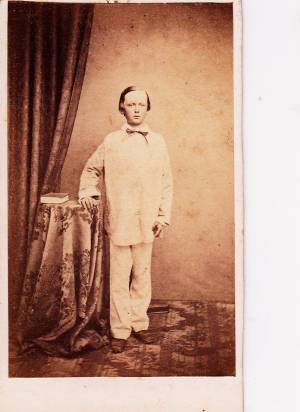
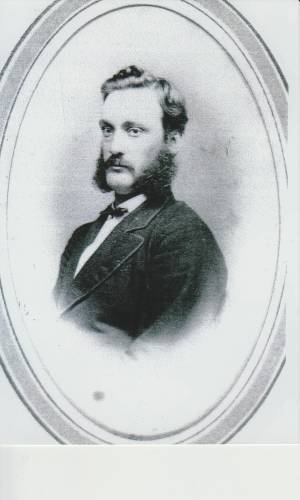
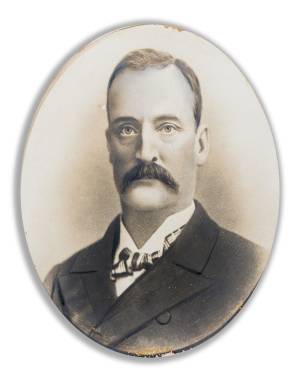
For other photos, click on Thomas de M. M-P photos.
The younger Thomas was adventurous and in 1874, for a short period he left working on Maroon to become a miner in the harsh Palmer River goldfields. His brother Morres wrote in a letter that, after Thomas returned from the Palmer in ill-health, he remained on Maroon while Morres had to leave, presumably because the property could not support them both. It appears that TLM-P handed over management of Maroon to Thomas de M. M-P in 1888, after TLM-P returned from an overseas trip.11) Given the timing of the handover, it is likely that Thomas proved his ability to run Maroon when his father was away.
In later life Thomas, like his father, bought a considerable amount of property in Queensland: Darbyshire lists nine purchases between March 1877 and January 1881, at Melcombe (Maroon), Telemon and Mogill.12) At some stage Thomas de M. M-P owned, with his brother Hugh, Annie Vale station.13) In 1880, he was listed as being at Moonbago, South Kennedy, Bully Creek.14) At the time of his father's death, in 1892, he was in partnership with his father running a property 'Bullywallah', Bulli Creek south-west of Charters Towers, Queensland. Possibly Moonbago was part of this property.15) As there is no mention of Maroon in TLM-P's will, and T de M M-P was left the smallest legacy of any of his father's children (£1,000)16) the assumption is that his inheritance was secured (like much of that of his sister Rosa) before his father's death. A New Zealand paper reported that Thomas de. M. M-P, at the time of his death, owned Aberfoyle station, previously owned by his father and brother-in-law John Jardine; after he died the property was sold by his executors.17)
Like his father, Thomas de M. M-P took advantage of the 1868 act which allowed people to 'select' land to farm. Angela Collyer18) lists his four selections around Maroon:
| Lease 1164 | 1 October 1870 | Portion No. 9 | Melcombe parish | 320 acres |
| Lease 1594 | 5 August 1872 | Portion No. 12 | Melcombe parish | 1093 acres |
| Lease 1662 | 24 October 1872 | Portion No. 12 | Telemon parish | 3810 acres |
| Lease 1968 | 24 September 1873 | Portion No. 26 | Telemon parish | 705 acres |
A total of 5,928 acres (nearly 2,399 hectares).
At Maroon, Thomas de M. M-P developed a strong reputation as a skilled breeder of shorthorn cattle: something his father had also done since his days at Bromelton station. Thomas de M. M-P appears to have visited Scotland in 1894 where he was reported as a 'prominent Queensland cattle breeder' with plans to export cattle.19) These plans were implemented with good results.20)
Like his father, Thomas de M. M-P had a passion for horses. He bred 'grade Arab horses', with some from Arab stallions imported 'direct from Arabia.'21) During a visit to India, he 'canvassed the prospects for Queensland horses in the remount [army horses] trade'. He followed this up by bringing together a number of fellow horse breeders during the 1892 Brisbane Exhibition week, advocating that they become regular traders for remounts. Like his father, he deplored the emphasis on sprint events for horses, designed to maximise gambling, which meant a reduction in Queensland horses' stamina.22) He was a founding member of the Belyando Picnic Race Club's Committee of Management which organised the first race meeting at Lanark in 1884. He was also Chairman of the South Kennedy Picnic Race Club's Committee of Management from c.1887: his horses won prizes at the Club meetings. In 19-20 July 1892, the Belyando Picnic Race Club held its races on an unfenced course at their President's (T de M M-P) home Bulliwallah: they continued to race at Bulliwallah until at least 1896 before a permanent course was built.23) Fox's History of Queensland24) summarised T. de M. M-P as having “enjoyed a wide reputation as a breeder of prize stock, his shorthorn cattle and Arab horses carrying off many of the most coveted honours of the day. He owned the Arab stallion “Pathfinder,” at the time one of the best-known horses in Queensland, and also imported from India “Trojan,” another noted Arab sire, both of which accounted for prize stock of the highest quality.”
One of Thomas de Montmorenci M-P's claims to fame is that he and a tutor at nearby Unumgar Station, Peter Pears, were the first Europeans to climb Mt Lindesay, in 1872.25) His wife Mary believed that the pair were actually the second, with the first ascent in the 1840s: that claim is uncertain. Thomas de M. M-P passed on his fascination with climbing Mt Lindesay to his son Thomas Bertram, who, with his cousin Standish Lightoller, climbed it in September 1902.26) 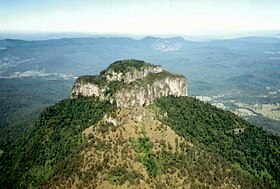
Thomas de M. M-P contributed to numerous local organisations. He was active in local government - the Boonah Shire Council - being elected a member of the Goolman Divisional Board from 1889-92 and 1895-99, including Chairman in 1896-97.27) He was also Vice-President of the Queensland Chamber of Agriculture.28) He was the founding President of the Fassifern and Dugandan Agricultural and Pastoral Association; on the first Committee of the General Hospital at Boonah as well as the Boonah Literary and Debating Society. He donated the land for the first Maroon School which opened in 1891, mainly for the children of settlers taking advantage of the closer settlement acts.29) In addition, he was known to have a good relationship with the local German settlers.30) Despite local support, he failed to gain election to the Queensland Legislative Assembly for the seat of Fassifern in 1896.31) In 1901, despite being supported by the Commonwealth Electoral League 32) he also failed in his bid to be elected to the Queensland Senate, though he gained a respectable 13,236 votes.33) On 11 March 1902, he was successful in his bid for higher public office, elected to the Legislative Assembly as the member for Fassifern.34) He died at Maroon exactly 9 months later, on 11 December 1902.35)
Thomas de Montmorenci M-P and Florence Claudia Moore36) (c.1861-1901)37) married on 18 March 1878 at the Holy Trinity Church of England in the far north Queensland town of Bowen.38) Like her father Henry 39) Moore (or Moor), Florence was born in London. Her mother, with the wonderful name of Georgiana Boadicea Maria Leathant, was the daughter of Charles Leathant; she and Henry married at St Pancras Church on 22 July 1857. They lived in the London suburb of Highgate. Henry died on 11 February 1861 and was buried in the famous Highgate cemetery.40)
Florence and her mother appear to have emigrated to Australia in 1862, the year after Florence's father died.41) It is probable that Florence's mother had already re-married, to Henry J. Jones who, at the time of Florence's marriage, worked for a bank in Bowen, Queensland.42) For that reason, Florence is sometimes referred to as Florence Jones.43) TLM-P and Nora both found Florence difficult. Nora was always discerning about people, and she wrote to Rosa that Florence easily took offence, imagining that people were slighting her and referring to her mother having been a forewoman in a shop. While Brisbane society was snobbish, the colonies were a place where people could rapidly ascend the social scale and Nora was probably correct in saying that no-one else cared. Nevertheless, Nora told Rosa, Florence was haunted by her mother's unladylike past. She had also snubbed anyone she thought of an inferior class, so consequently had few friends. Florence's saving grace, in Nora's eyes, was that she was a devoted wife and mother. 44).
Florence and Thomas de M. had the M-P fertility. She was 18 years old when she married, her husband 30, and she conceived almost immediately, going on to have 5 children in 8 years. She died aged 40 in 1901 suffering from the endocrine disorder, Addison's disease.45) She was buried at Maroon but in 1920, after the property was sold, was re-interred in the family plot at Toowong cemetery.
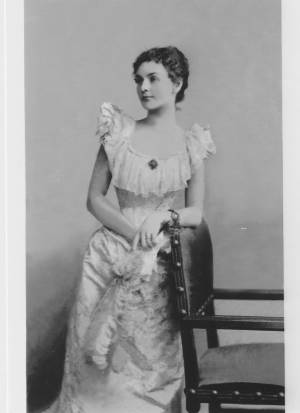 For other photos of the beautiful Florence and her possessions, click painting, photos Florence
For other photos of the beautiful Florence and her possessions, click painting, photos Florence
Children
Thomas and Florence had four daughters and one son.46) See the sidebar entry for Thomas Bertram M-P and his sisters Florette, Mabel, Ethel and Phyllis M-P. They ranged in age from 16 to 24 years old when their father died.47)
Thomas de Montmorenci and Mary Bundock
On 30 August 1902, the year after Florence died, Thomas married 57-year-old Mary Bundock (1845-1924).48) Thomas' young step-brother Robert was reportedly his best man at the wedding.49) The Bundocks and M-Ps were on visiting terms at least from 1880,50) and Thomas de M. M-P had a connection to the area where Mary Bundock's family had a property, Wyangarie, on the Richmond River in northern NSW. Isabel McBryde states that Mary's father owned a property called Kooralbyn near Beaudesert (and thus Maroon) and also owned Bulliwallah, south of Charters Towers, which appears also as a M-P property. One bond between Thomas de M. and Mary was their love of horses. Mary was known as 'a fearless horsewoman, and would ride for miles to set a broken limb or succour a settler in distress in that then sparsely settled district'.51) Oral history recollections are frequently not-quite-right, and the former description particularly fitted her sister Alice,52) but perhaps both sisters were that way inclined. Another recollection of Mary described her as 'the Florence Nightingale of the Upper Richmond, of whom all the early settlers still speak with affectionate regard. She was a wonderful woman, admired and remembered by all with gratitude.'53)
The family story54) is that it was a marriage based on friendship and trust, to enable Mary to look after Thomas de M.'s soon-to-be orphaned children and Maroon. Thomas de M. was already suffering from the stomach cancer that would kill him 4 months after the wedding.55) Maroon was struggling due to the prolonged drought, and Thomas B. was only 19 years old, too young to effectively take on such a challenge. His four sisters ranged in age from 23 to 16 years old. Three months after he married Mary, Thomas de M. was described as an 'invalid'; his sister Lizzie and brother Egerton came to Maroon to say goodbye.56) A month later, on 11 December 1902, he died there.57) Like Florence, he was buried at Maroon but on 25 June 1920, re-interred in the family plot at Toowong cemetery.58)
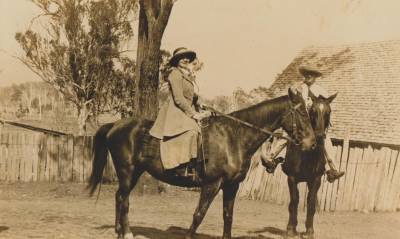 The man is reputedly Thomas B. M-P: is the woman Mary Bundock?59)
The man is reputedly Thomas B. M-P: is the woman Mary Bundock?59)
The newly-wed, newly-widowed Mary stayed at Maroon running the property for some time. Today Mary Bundock is renowned for her significant contribution to European knowledge of Aboriginal arts and crafts through her work as an artist and anthropologist-collector. Dring 1885-92, she collated two ethnographic collections, one which she gave to Rijkmuseurn voor Volkenkunde, Leiden in the Netherlands where it was valued; the other to the Australian Museum in Sydney. The latter collection was first displayed in 1895 as a fund-raising exhibition for the Women's College at the University of Sydney. Archaeologist Isabel McBryde judged the collection in Leiden, the only one which survived, to be 'large, comprehensive and meticulously documented' in a highly professional manner. What remains unexplained was how Mary Bundock had the skills to do this despite 'few opportunities for scientific contacts and indeed little formal schooling'.60)
Mary Bundock also wrote two works of great value: 'Notes on the Richmond River Blacks', and an untitled history of early European settlement in the Richmond River valley, both now held at the ML: neither was published during her lifetime.61) The significance of Mary Bundock's work was enhanced by her close bonds with, and her knowledge of the Bandjalang dialect spoken by, Aboriginal people in the Richmond River district.62) It meant that her ethnographic collections were 'made in close collaboration with members of the local Wyangarie Aboriginal community'.63)
Mary M-P died on 9 April 1924 while visiting Perth. 64) Her will reveals her interests and closeness to her own and step-family. She left ₤2,000 each to St Paul’s College and to the Women’s College at the University of Sydney, to establish respectively the W.C. Bundock Scholarship and the Ellen Bundock Memorial Scholarship, in memory of her parents.65) She left money to her godchildren, maid and family members (both those related by blood and her husband's family), as well as an annuity to her widowed sister-in-law, Lizzie Jardine. The reason for the latter is forgotten, but perhaps due to Lizzie's relative poverty and her closeness to her eldest brother, Mary's late husband. Her step-grandson Thomas L. M-P received ₤300 along with a silver watch once belonging to his grandfather, Mary's late husband. She also bequeathed jewellery to her step-daughter-in-law Lizzie, her husband's sisters and a step-grandchild (Diana Herring).66) Her religious convictions is shown in her leaving ₤500 to the (Anglican) Brotherhood of the Holy Shepherd, Kyogle.67)
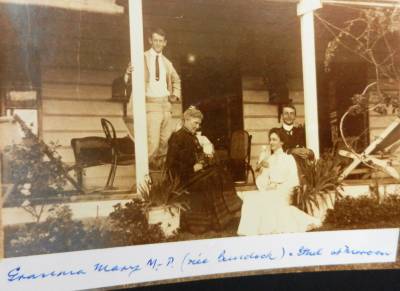 Mary Bundock in old age with her step-daughter Ethel on the verandah at Maroon.68)
Mary Bundock in old age with her step-daughter Ethel on the verandah at Maroon.68)
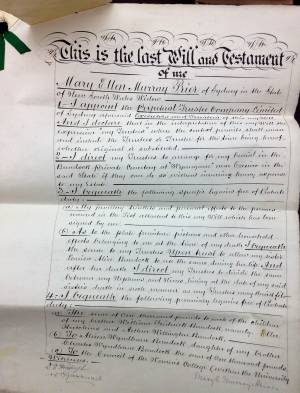 Mary M-P's original will with its beautiful, laborious handwriting.
Mary M-P's original will with its beautiful, laborious handwriting.
Whose?
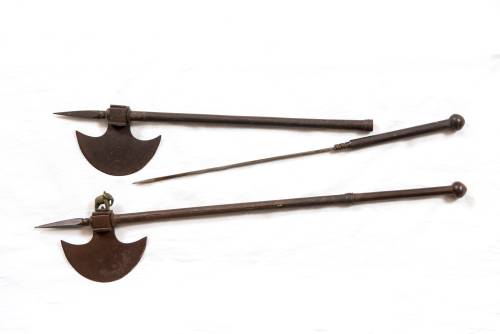 These are Indian tabar axes.69) Damien Fegan has identified them (from a photo) as more likely to be used as dervish axes than as combat weapons and thinks they probably date from no earlier than the mid-19th century. The dating suggests they were bought by Thomas de M. M-P when he travelled to India. The handle of the 'weapon' doubles as a sword. One of the axes has an elephant on it; the blades originally had engraving on them, which also appears to suggest they were ceremonial arms rather than weapons designed for use in war.70)
These are Indian tabar axes.69) Damien Fegan has identified them (from a photo) as more likely to be used as dervish axes than as combat weapons and thinks they probably date from no earlier than the mid-19th century. The dating suggests they were bought by Thomas de M. M-P when he travelled to India. The handle of the 'weapon' doubles as a sword. One of the axes has an elephant on it; the blades originally had engraving on them, which also appears to suggest they were ceremonial arms rather than weapons designed for use in war.70)
Thomas de M. M-P also wrote advocating a tax on stallions in order to weed out weaker horses and improve the breed overall.((It was republished in Waikato Times, 24 November 1894, p.15, see https://paperspast.natlib.govt.nz/newspapers/WT18941124.2.55?page=2&phrase=2&query=Murray-Prior.